Table of contents
Some backstory
Bits
The Bosal
Mechanical Hackamores
Which is best
Sidepulls and other bitless options
Combination devices
What to consider when choosing a bit or bitless option
Poll: What do you use on your horse(s)?
How I learned about bits
Shopping
See my related post about art: Bits and bridles on statues as seen in Madrid.
A history of this blog on bits, bosals, hackamores, & sidepulls
For me, only the “bit” part of bits, bosals, hackamores, and sidepulls has been important. Then, about a year ago, I decided to dive into endurance riding with my Arabian mare Lady. Or anyway, with the urging of a friend who boards my mare, I decided to wade slowly into it. After all, that’s what Arabians do best, (very) long distance racing, and I had no other plans for Lady.
After an intro ride through which we ambled (my ideas of training for races include NOT racing until your horse is ready to win), I joined the American Endurance Ride Conference and received a bumper sticker, which I put on my car, and a rule book, which I read.
The fun of online fora
Once I became a member of AERC, I also joined their public Facebook group. The AERC wall is an amazing testament to the ability of horse people to disagree with each other, and of course I have been unable to resist participating in some of the discussion. On the whole, I have learnt far more than any meager amount others may have learnt from my comments. One of the things i have learnt is that people come to endurance riding with all levels of horsemanship. Most people, no matter what their prior experience, come eager for information. (Facebook page for newbies)
There have been many posts asking for suggestions on what I’ll call headgear–ie bridles, bitted and bitless; hackamores of various types, and even halters. Some people want to know about bits, others want to know about bitless options. Many people ask very good questions, and the comments on a facebook post just do not provide the best place to answer. And of course, there are bound to be at least two opposing opinions on any topic. Since this is my blog, I get to do the instructing opining (opinionating) uninterrupted (although naturally I welcome any and all comments).

Caveat
Before I begin, let me make it clear that I am no expert. I have never even seen some of the things endurance people put on their horses’ heads. That is, I have not seen them in person, much less ridden with them. I’ve seen plenty of pictures since joining the AERC Facebook pages. I have used many bits, and I have ridden many horses, and what I say here will be based on my experience with them (my horsey About me). Hopefully if I make any mistakes, someone will be kind enough to point them out.
A very brief history of bits
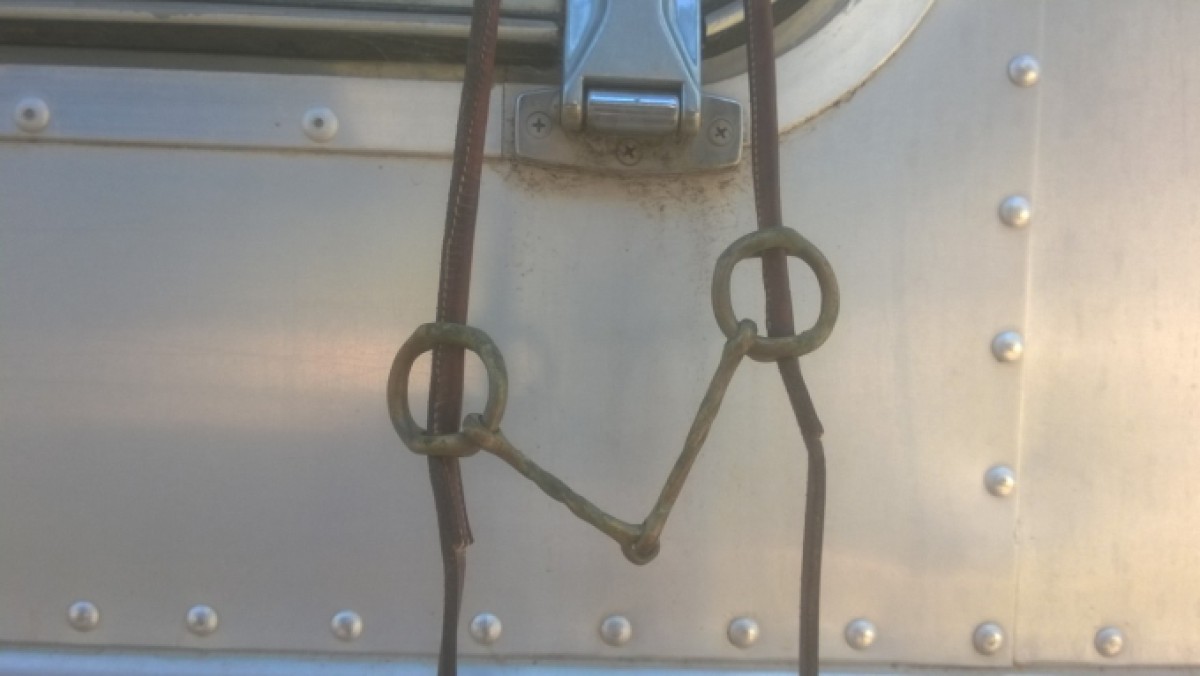
People have been using bits for millennia, far longer than we have been using stirrups (Charlemagne is often credited for spreading the use of the stirrup in Europe, but it had been around since the 8th century and came from Asia, where if I am not mistaken it had been in use since the beginning of the Common Era). Evidence of metal bits (mostly bronze) from the Bronze and Iron Ages, around 1200 BCE, comes from Mesopotamia, specifically the Luristan region (now Iran). Before then, different materials such as bone and wood were used. (An interesting article on the double bridle provides some background.) Now, most bits are probably stainless steel, but sweet iron, nickel and copper bits have been used, and plenty of mouthpieces are rubber or plastic.
Snaffle or curb?

Generally bits are categorized as either snaffles (direct pressure on horse’s bars, tongue, and lips) or curbs (indirect pressure applied via leverage, usually with a shank, that works on the poll, chin, roof of mouth). The mouthpiece of a bit can be unjointed, straight or curved, metal (I prefer copper), plastic, or rubber. In general, more joints means a milder bit, but with one joint, the tongue can be pinched (although I’ve ridden hundreds of horses with a simple single-jointed D-ring bit, and never had a tongue problem). Curbs often have raised ports in the center; the higher the port, the more severe the bit. Longer shanks also means more leverage and more potential severity.

Some snaffles also have raised mouthpieces or ports to relieve tongue pressure. This Myler bit is an example of a high port snaffle. I prefer this one, (Myler Mullen Low port) because it has a lower port, but it really depends on the horse.
The bosal
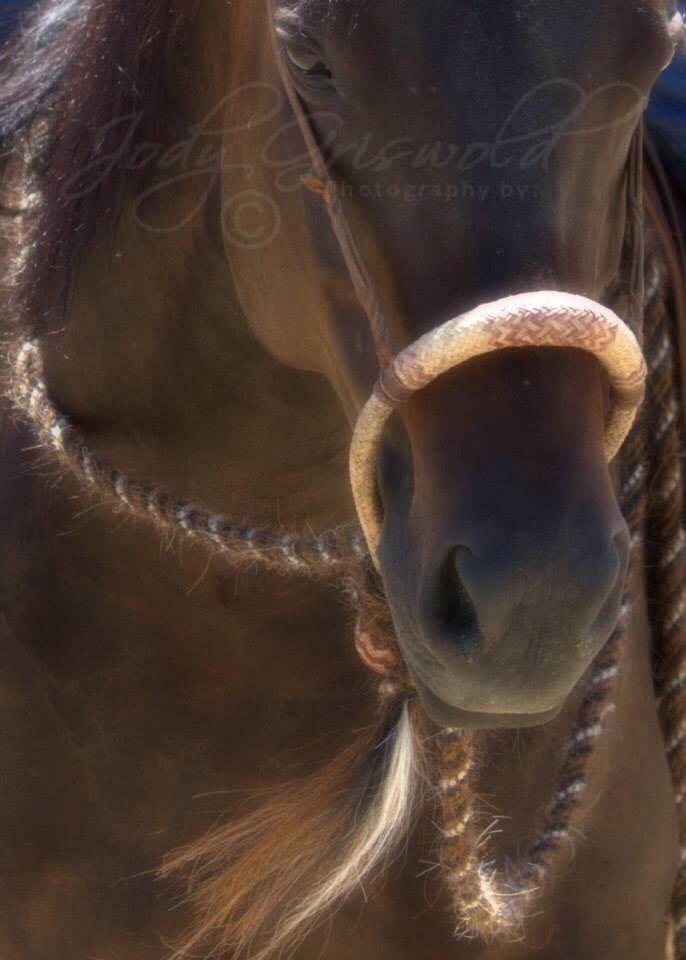
The bosal has been used traditionally to start horses in the Vaquero tradition. It is usually made of rawhide, and consists of the nosepiece, which should fit snugly to avoid chaffing, a crownpiece or “hanger”, and the mecate, or reins. The bosal ends in a “heel nut” to which the mecate is tied. (Note that this is the primary difference with mechanical hackamores and sidepulls, all of which have reins that connect at two separate points and can offer a more direct sideways signal.)
The bosal works by applying pressure to the horse’s nose, cheeks, and chin. Thicker bosals are less severe, and knots or protuberances on the noseband are placed there to apply pressure to nerves.
I’d love to get a good bosal hackamore, but I’d want help fitting it, and the good ones are too expensive for a PhD student.
Jenni Grimmett’s blogpost on using the bosal
Mechanical Hackamores


Mechanical hackamores have little in common with bosals beyond the pressure exerted on the nose. I don’t remember having used one, so these comments are based on observation, not experience. The first thing I would do when considering such a device is ask where it is going to exert pressure. All of the above pictured hacks (and others, as far as I know) are, like curbs, leverage devices.
Mechanical hacks are leverage headgear
Like curbs, the longer the shank, the greater the leverage (i.e., the more force the same pressure on the reins will exert). Pressure will be applied on the nose (narrow nosepiece = more severe, and lower down on face = more severe) and on the chin via the curb strap or chain (chain is more severe, narrow is more severe). Pressure is also applied to the poll of the horse, depending on the length and angle of the purchase (the part of the shank that is above the nosepiece and to which the crownpiece is attached. At least, it is the purchase on a curb bit.)
Bit, Bosal, or Hackamore: Which is best?
Hackamores are NOT gentle alternatives to bits. They are alternatives to bits that may be more or less severe, just as bits may be more or less severe, depending on the bit and the hands that hold the reins. As always, good hands will make all the difference. A bit or hackamore is only as severe as the hands that hold the reins. A mechanical hackamore can have more stopping power than a snaffle bit, but I have seen a racehorse get away with her jockey and run three laps in a long-shanked mechanical hack: she figured out in about two strides that all she had to do was pick her head up and stick her nose straight out.

A mechanical hackamore would be a good option for a horse that doesn’t like a bit but needs a bit more control than a sidepull. I see a lot of endurance riders and happy endurance horses using mechanical hacks. I would consider using one with my mare, who is very trained, and might like to eat more freely. However, I still don’t know how well a hack will work for picking up a tripping horse. (feel free to leave comments on this question!!)

Sidepulls and other bitless options:
I see sidepulls as an improvement on halter with lead-strap tied to both sides (something most of us have done to ride in from the pasture or when too lazy to tack up the horse). They are all variations on ways to control your horse by pulling on its head, without leverage. I start horses by longlining and then riding in a snaffle, but if I were to start without a bit, I’d use some version of a side pull, because if the horse already knows how to lead well, it is very intuitive to follow the pull of the rope on the side of its face.

Safety first!
Although you can find specialized sidepulls that exert force on pressure points, if the horse wants to ignore one, it will. This is why I’ll probably ALWAYS use a snaffle the first time I get on a horse with intentions of riding forward and controlling. I can lift a horse out of a buck with a snaffle; doubt a sidepull would work as well. I can stop a galloping horse with a snaffle; I KNOW a sidepull won’t work at all to stop a serious runaway. However, if we are operating under the assumption that your horse is trained, then a sidepull seems like comfortable headgear for a trail ride or endurance. The horse can drink and eat, and can be tied directly from it.
These days, there are lots of sidepulls to choose from. As always, a narrower nosepiece means more severity. Just like with the bosal hackamore, protuberances that exert force on pressure points also make the headgear more severe. However, a horse that doesn’t yet have good brakes may not be not a good candidate for a sidepull on the open trail (a closed arena doesn’t present that much of a problem). Most people simply do not have enough strength to stop a horse from running through a noseband.
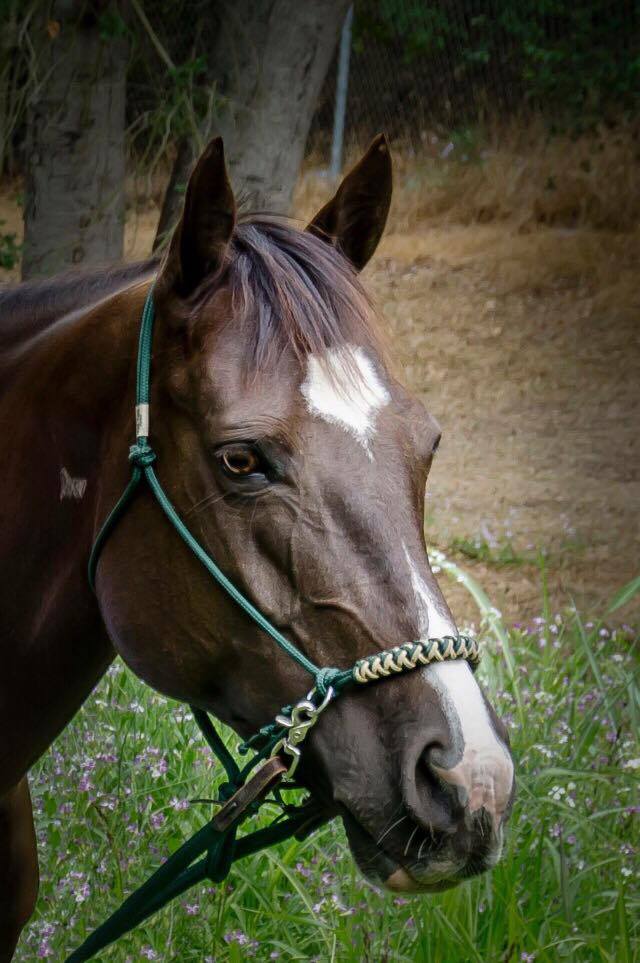
Combination headgear:
Myler combo bit
“Bits, bosals, hackamores, and sidepulls” was inspired by a post on the AERC page about a Myler combination bit (pictured to the right).
This bit works like a hackamore by putting pressure on the nose, but it also has a mouthpiece that can work as a snaffle (if the reins are attached to the largest ring–in this case, the noseband/curbstrap won’t exert pressure) or as a curb. The middle ring will exert some pressure on poll, chin, and nose, and the lower ring will exert the most pressure. There are many options similar to this one (e.g., the Happy Mouth “Shaped Mullen Mouth Hackamore bit” … in some senses an oxymoron of a name).
Why use combination devices?
I find these contraptions very interesting. I can’t imagine ever needing to put that much stuff on my horse, but some people love them. I’d worry about there being so many pressure points, and you’d want to remember that as with all leverage bits, the longer the shank (affected in this case by where you attach the reins) the more severe the bit/hackamore. However, judging by comments on facebook and retail websites, many people and horses love this particular combination.
Other combination headgear alternatives involve ways to attach nosepiece, crownpiece, and chinstrap to different types of round hardware (see picture below). I had been ignorant of these options until i started this blog project, but they seem like good ways to experiment with bitless headgear. It would be important to think about how much and where pressure is applied when adjusting these options. (This article offers more detailed information on this type of headgear, as well as links to pieces on hackamores, etc., by the same author. I have not read them all.)
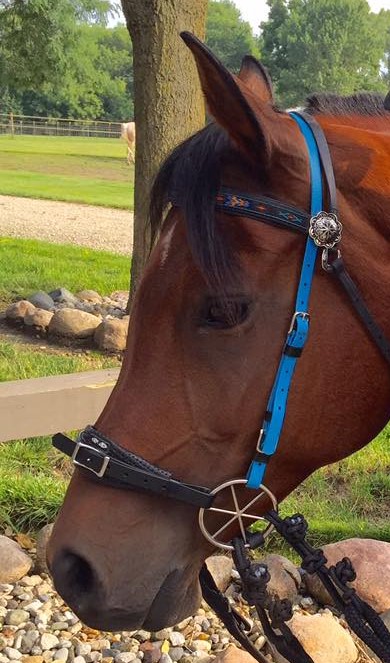
Similar wheel-type
What to think of when choosing a bit What I think of when I look at a bit or a bitless device, and what I would advise others to think about:
- How does it work?
This is the most important part. - Can I control my horse with it?
This is the second most important part. - Is it going to make communication easier?
- Can it possibly pinch by horse’s lip in any way?
- Is it the mildest, most comfortable way to communicate with my horse?
- Specific to endurance: what about eating and drinking?
Note: In general, I believe a snaffle (or direct-pressure bitless headgear) to be kinder than a curb (or shanked) option. However, rough hands make a snaffle unkind, and a nervous rider may be much better off with a curb. If the extra stopping power gives confidence, then by all means, use a shanked option, but use it gently. And never sacrifice safety to some ideal of humane treatment or natural horsemanship. If you need a curb (or stronger hackamore), use one. If you need a whip, use one. Just remember to ask before telling your horse. Just like people, horses don’t like to be ordered around and nagged all the time, and they prefer to be asked rather than told.
In all cases, the key to good communication is release of pressure. But this is about headgear, not riding, so no more training advice.
Bits, bosals, hackamores, and sidepulls in brief
Bits, bosals, hackamores, or sidepulls?
Difference between bosal and mechanical hackamore: bosal mecate (reins) has one point of attachment, beneath the chin, whereas mechanical hacks have reins attached in two places, and are leverage headgear (which means pressure on poll as well as nose, chin, and cheeks of bosal, and of course, more power). Sidepulls also have two reins, and work via direct pressure. Bits go in the mouth and therefore exert pressure on bars, tongue, and skin, as well as roof of mouth in the case of a curb with a port. Have I forgotten anything?
What do you use on your horse(s)?
How I learned how bits work:


When I was eight years old, I was taught how to ride in a Weymouth, or double bridle. I mention my age because I have heard many people exclaim at the complexity and cruelty of a double bridle without understanding how it works and without ever having used one. The double bridle, if used properly, is an ideal way to obtain lightness. The snaffle (called a bridoon or sometimes bradoon) is used to lift the poll, and the curb (Often called a “weymouth” bit) is used to set the angle of the head. Importantly, the curb also provides braking power. My first horse, a 5-year-old Morgan gelding that had been a park horse, loved to grab the eggbutt snaffle my jumping trainer insisted I use in his teeth, and run bucking to the end of the arena, where he could throw me against the wall. He couldn’t get away with me (a small 9-year-old) with a Weymouth.

Although I rode that gelding on the trail in a Weymouth (he could and would have galloped for miles across much cattle country in a snaffle), I would never use one for endurance riding. Too much stuff in a horse’s mouth.
But I’d love the opportunity to ride saddle seat again (the only real reason to use a double bridle outside of upper level dressage).
Another bit I like:
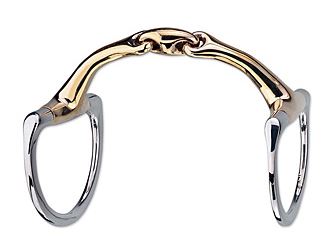
Shopping:
Very kind rubber-mouth Dee
Basic copper-mouth Dee
Very nice and expensive double joint Dee
Herm Sprenger Copper Plus Double Joint Eggbutt Snaffle
Nice (and expensive) copper-mouth D-ring double jointed bit
Zilco Flower Hackamore (Tough-1)
S-hackamore
Copper-mouth gentle grazing curb
Horses that chew the bit a lot might like rollers or crickets to play with. This mild copper-mouth curb is nice.
Myler Mullen mouth combo bit (I think this would be better than the lowport above).
Western-style Bitless Bridle and basic sidepull
English-style bitless bridle and sidepull
Nylon bitless bridle
Very mild hackamore (I used one like this with my mare… but wouldn’t if I weren’t sure the horse will stop!)
Big mechanical hack selection



Interesting discussion. I like the fact that you discuss the idea that a hackamore, of any type, is not a ‘gentle’ option for riding. I think many people don’t understand how damaging they can be. I actually do not like mechanical hacks. One thing you didn’t mention was that the pressure applied by a mechanical hack also hinders the horse’s airways. I have seen this first hand and believe they are a terrible option for running horses. We start every horse in a halter for the first ride or two, but switch almost immediately to a bosal Hack. The art of the bosal hackamore is all but lost also, and when a horse can spend a couple years in one, learns proper self carriage, neck reining, and lightness. But it must be used properly – and is much more effective at stopping a run-away colt than is a snaffle bit.
The single jointed snaffle is also not a good option for starting colts and riding colts. when pressure is applied it jabs the top of their pallet with the point. If you are going to use a snaffle for basic training, it should be a three piece mouth piece. Even then, if riding young horses, a bit should not be used until their bottom jaw is fully developed (5-6 years old) because the narrowness of the immature jaw does not allow the bit to be seated or held properly. I have made all of these mistakes – and learned from them, I hope 🙂
I am a fan of double reins used on a ported correction bit, effectively turns it into a curb or a snaffle, depending upon how you use the reins at any given moment. A double bridle without the double bit. It especially makes retraining a hot horse much easier – and eliminates the martingale – of which I will also never use. It gives you quiet effective control of the horse and its level of collection at any time needed. I run a hot ha/saddlebred who likes to spook sideways at the drop of a hat at the road trot. The double reins allows me to lengthen him while maintaining a level of collection/control of the hind quarters that a simple snaffle doesn’t afford. Love this and enjoy riding this way on all horses who have progressed beyond a bosal Hack or have been ridden incorrectly in a bridle. Works also famously with the gaited horses. Your curb rein is used for vertical flexion, your snaffle rein is used for lateral flexion.
I am also a fan of a double bridle. I have run LDs with a double bridle on a very calm and responsive horse. On the LD most of the time the only time to stop is at the vet check anyway 😉 However my gelding was able to eat and drink effectively with the double. The art of lightness in the double has been all but lost, and I believe that is a sad state of affairs. Used properly it can make communication more subtle and is an unbelievable tool of softness and lightness. It is an amazing way to ride even quiet horses – and should not IMHO be reserved for upper level dressage or ram/jam saddle seat riding. George Washington rode in a double – you will find paintings of many of the horsemen in ages past riding in a double or with double reins. It is an almost lost art I am afraid.
I loved your article and hope you continue in your endeavors in all things horsey. You have some insights I don’t hear very often! Makes me super excited to hear 🙂 At the end of the day, any good horseman can use almost any tool and they learn to use different tools based on what the horse they are riding at the time presents to them for challenges. I aspire to greater horsemanship – I surely hope to never stop learning! Sometimes what works well for one style doesn’t work well for another, and we are all so greatly influenced by our own experiences, body shapes and conditions, and the horses we choose to ride that there is never only one way. I believe understanding the mechanics of bits and bitless bridles is important to allow the proper selection for each horse and rider combination. Thank you for your wonderful post!
Thank you for the fascinating reply 🙂
Very interesting information about the airways and mechanical hackamores. I hadn’t thought of that (and have no experience with them).
I too like double reins on different bits, especially mild Pelhams. I did not mention them because my post would turn into a book if I addressed every bit I’ve ever used, but you are right, it’s a useful tool.
Agreed that a double bridle is of course great for quiet–and light–horses. In fact, it’s all about light. (and a good English pleasure or park horse is LIGHT, not rammed into the bridle!). Its purpose is to finesse communication; you just cannot do the same thing with a snaffle (or anyway, it’s not as easy). And it works for all sorts of horses.
One of my best double bridle stories happened when I was training racehorses in Spain. I had a 3-year-old colt for sale that was pretty and nice to ride (a bit squirrelly, but hey, he was young) but SLOOOW. A man from Valencia wanted him for doma (Spanish style training), and told me that if I could get him going in a double bridle (that he provided), he buy the horse. The colt was sold in 3 weeks for the askign price and many oranges. By then, I had him doing flying lead changes (looks more impressive than it was, since all well-trained racehorses know how to do flying changes) and pirouettes, all in that double bridle.
Just a heads up re curbs–the severity is not in the port. That provides tongue relief, so the lower the port, the more severe it can be because of tongue pressure coupled with leverage. The primary severity comes from the ratio of shank above the bit (where the headstall straps into the bit) to shank below the bit. That plus the tightness of the curb chain affects the degree of leverage. Also, straight shanks vs curved shanks affects the leverage ratio–a straight shank bit is going to have less signal (contact warning the horse that you are taking hold) than a curved shank. Shanks that are curved back have more signal, so a lighter touch is more effective. There’s some good books out there including one called Bridles and Bits which talks about this effect–or look around on the Western Horseman webpage.
Indeed! You have good points. I did not address them because I would have been writing forever (and my focus was not the curb). In fact, the only place where I mention the purchase (the part of the shank above the bit) is with reference to hackamores. There is also the issue of swivel shanks, and so on…
Maybe I should do a separate blog post on curb bits.
With regard to ports, you are only partially correct. Some ports do provide tongue relief, but if they are high, they also apply pressure to the roof of the mouth (think spade bits for an extreme example). This is often why you see horses with curbs opening their mouths.
Pingback: Three’s the charm – Wild Woman's World
Pingback: Changes – Wild Horses
Pingback: How to discourage questioning in an online horse forum : Wild Horses
Pingback: Using a whip is not horse abuse, it's communication
My mare has an old neck injury, probably from roping. She is very sensitive at her poll and the top of her neck/mane. What would be the best bit/bridle for her that would NOT put pressure on her poll? Any suggestions would be appreciated, thanks!
What an interesting question! The main thing to avoid would be leverage bits, such as curbs, or mechanical hackamores (these also work via leverage). A shank and purchase (where you attach the headstall) will cause pressure on the poll when you pull on the reins.
Any sort of snaffle should be fine. You could also use a bosal or a bitless option… just nothing with a shank or purchase.
I would probably just use a simple D-ring or eggbutt snaffle. No pressure on poll at all!
I’ve been using a simple D ring snaffle, so it’s good to know that it’s easy on her poll. We’re trying osteopathy and acupuncture soon to see if we can release the tension up there. Thanks very much.
I’ve had GREAT luck with mechanical hackamores, and they come in all ranges of gentle to harsh, depending on the nose band style, length of shanks, curb strap or chain, etc. They are VERY customizable for each horse and the amount of control you need. News alert……..if you are interfering with their breathing using a mechanical hack, you have it way, way, WAY too low on the nose! You are not fitting it correctly if you are interfering with their breathing! Can’t blame the tool for an inept user!
Mechanical hacks, gentle ones with flat nosebands, are very easy on the horse because all pressure is off until you actually use the reins. It gives the horse a lot of freedom.
Pingback: Bits and bridles on statues, as seen in Madrid